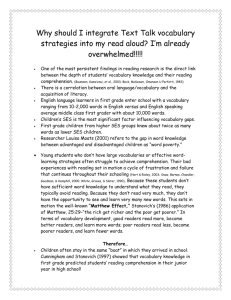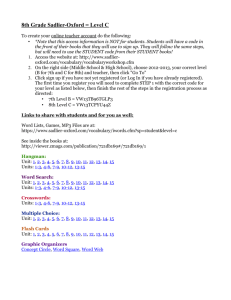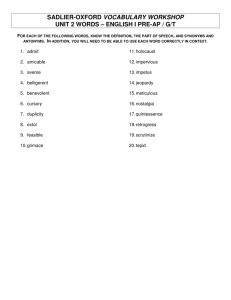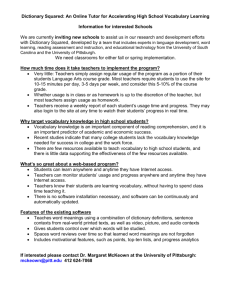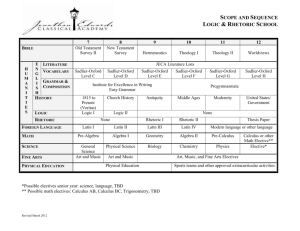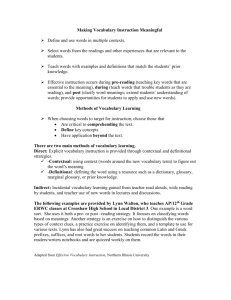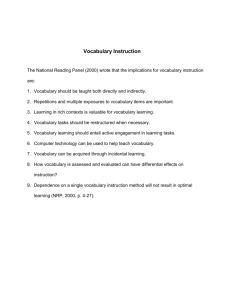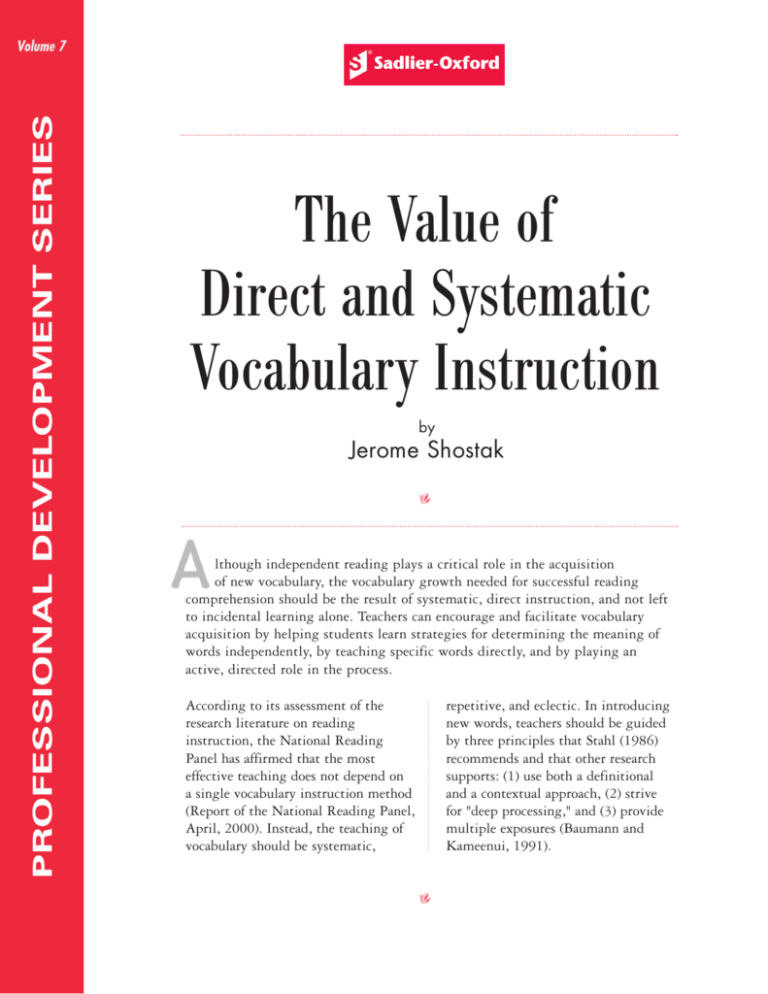
PROFESSIONAL DEVELOPMENT SERIES
Volume 7
The Value of
Direct and Systematic
Vocabulary Instruction
by
Jerome Shostak
A
lthough independent reading plays a critical role in the acquisition
of new vocabulary, the vocabulary growth needed for successful reading
comprehension should be the result of systematic, direct instruction, and not left
to incidental learning alone. Teachers can encourage and facilitate vocabulary
acquisition by helping students learn strategies for determining the meaning of
words independently, by teaching specific words directly, and by playing an
active, directed role in the process.
According to its assessment of the
research literature on reading
instruction, the National Reading
Panel has affirmed that the most
effective teaching does not depend on
a single vocabulary instruction method
(Report of the National Reading Panel,
April, 2000). Instead, the teaching of
vocabulary should be systematic,
repetitive, and eclectic. In introducing
new words, teachers should be guided
by three principles that Stahl (1986)
recommends and that other research
supports: (1) use both a definitional
and a contextual approach, (2) strive
for "deep processing," and (3) provide
multiple exposures (Baumann and
Kameenui, 1991).
SADLIER-OXFORD
Professional Development
Series
new meaning (Nagy, 1988) and making the
word both "more explicit and employable" and
fully conceptualized (Baker, Simmons, and
Kameenui, 1995a). It means, according to
Baumann and Kameenui (1991), being able to
identify a synonym for a word, to generate an
oral definition, to place a word within a
semantic category, to discriminate between a
word’s denotative and connotative meanings,
to express the obvious and subtle differences in
meanings among a set of synonyms, and to use
a word sensibly in an oral or written context.
How Do Students Learn New Words?
We know that students in grades 3 through
12 are likely to learn about 3000 new words
each year (Nagy and Anderson, 1984; Nagy
and Herman, 1987). And, as Nagy, Herman,
and Anderson (1985) point out, this "massive
vocabulary growth seems to occur without
much help from teachers." In other words,
students acquire new vocabulary incidentally
and from several sources. They learn new
words from talking to friends and family
members, from listening to CDs and to the
radio, from watching movies and television
programs, and, most importantly, from their
reading. In fact, research shows that reading
is the single most significant factor in the
acquisition of new vocabulary (Anderson and
Nagy, 1991; Baumann and Kameenui, 1991).
But independent reading alone is not enough
to provide the kind of vocabulary growth and
development students need not only to be
able to communicate successfully, but also to
succeed academically and to perform well on
standardized tests. According to Chaffin
(1997) and Zechmeister, Chronis, Cull,
D’Anna, and Healy (1995), research has
shown that although reading is essential for
vocabulary growth and development, it is not
sufficient for most students because the
meanings they take away from their readings
will not be deep and enduring; nor does it
help them gain strategies for becoming
independent word learners.
Researchers agree that although reading
is indeed important, to achieve deeper, richer
levels of lasting vocabulary understanding,
direct instruction is more effective and more
efficient than incidental learning (McKeown
and Beck, 1988). Planned vocabulary
instruction in specific words is what is
needed, including specialized vocabulary
instruction in the content areas (Baker,
Simmons, and Kameenui, 1995b).
Research tells us that for students who are well
past the beginning stages of reading, learning
new words fully and deeply means much more
than simply recognizing those that are already
part of their oral vocabulary. For these
students, learning a word means acquiring a
2
SADLIER-OXFORD
Professional Development
Series
(Nagy, 1988). Nagy goes on to explain that
although definitions can play a key role in
vocabulary instruction, by themselves they
tell little about how a word is actually used.
He points out that given only a definition of a
word, students may have difficulty using it
meaningfully in a sentence. The definitional
approach is effective only when a limited
knowledge of new vocabulary is desired
(Beck, McKeown and Omanson, 1987).
What Kind of Direct Vocabulary
Instruction Works Best?
Traditional vocabulary teaching can be
categorized as following two general
approaches: definitional and contextual. Using
the definitional method, teachers have
students look up words in a dictionary, write
down and/or memorize definitions, use the
words in sentences, find synonyms, and then
complete worksheets or take quizzes. There are
some undeniable advantages to this approach.
For one thing, from dictionary definitions
students can gain a specific meaning of a word
they come across in their reading. For another,
they can gain key and interesting information
about the history of the word. Thirdly, they
can gain a better understanding of interrelated
words in word families. And, in addition, by
combing through dictionaries and all the
information they provide, students can gain a
better appreciation of language.
Examine the entry to the right for the word
allocate. It is not of the dictionary type, but
has unmistakable advantages. The definition
is brief and simple and designed for
maximum usefulness. Its intent is to give
students a good idea of what the word
means without extensive detail or secondary
connotations. Notice that the entry also
includes the word’s part of speech, its
pronunciation, an illustrative sentence
providing a context that clarifies and
exemplifies its meaning, and a list of
synonyms and antonyms.
Vocabulary Workshop ©2002, Level E (10)
In the contextual approach, teachers ask
students to infer the meaning of a word by
scrutinizing semantic, syntactic cues in a
sentence or group of words containing that
word, or by examining typographic clues
from charts, graphs, pictures and the like.
This approach also can be useful, but it
Although the definitional approach can
be both useful and necessary, learning
definitions alone can "lead to a relatively
superficial level of word knowledge [and] does
not reliably improve reading comprehension"
3
SADLIER-OXFORD
Professional Development
Series
should be noted that context clues alone may
provide only a partial meaning of a word and
occasionally may even be misleading (Nagy,
1988; Beck, McKeown and McCaslin, 1983).
One way, according to Stahl (1985, 1986)
and others, to make the contextual approach
more effective in helping the reader to
understand the meaning of a new word is to
imbed it within a rich context of supportive
and indicative information.
Both the definitional and contextual
approaches fit in an effective vocabulary
program (Stahl and Fairbanks, 1986).
However, the approach to vocabulary
instruction that researchers have identified
as being the most successful in providing
students with fuller, richer word knowledge
and increasing their reading comprehension,
is an eclectic, systematic one that not only
involves both of these approaches, but also
contains three distinct elements: integration,
repetition, and meaningful use (Nagy, 1988).
Look at the following contextual analysis
activity for the previously introduced word
sophomoric. In this completing-the-sentence
activity, the student is asked to write the
word that logically and meaningfully fits in
a given sentence. Notice the clues given for
choosing the right word and that the focus is
on the literal meaning of the word.
By integration, researchers mean that in
order for learning to occur, new information
must be integrated with and be built upon
what the student already knows (Christen and
Murphy, 1991). In other words, instruction
should guide students to use words and ideas
they already know to help them associate
meaning with words they do not know. One
teaching technique that supports this strategy
of drawing on students’ prior knowledge is to
have them complete a semantic map, a visual
tool that helps to make relationships among
words more clear. The one shown to the right
is for the word adversary.
Vocabulary Workshop ©2002, Level E (10)
4
Copyright © by William H. Sadlier, Inc. Permission to duplicate for classroom use granted by the publisher.
SADLIER-OXFORD SEMANTIC MAP BLACKLINE MASTER
Copyright © by William H. Sadlier, Inc. Permission to duplicate for classroom use granted by the publisher.
SADLIER-OXFORD SEMANTIC MAP BLACKLINE MASTER
SADLIER-OXFORD
Professional Development
Series
choose, from among two or more taught
meanings of a word, the only one that the
specific context will reasonably allow. (Note
that activities like this one give students
practice in the kind of skill assessed in the
critical reading section of the SAT I.)
Repetition is a second key quality of
instruction. Research shows that repeated
encounters with new words are essential if
vocabulary instruction is to have a
measurable impact on reading
comprehension (Stahl and Fairbanks, 1986;
McKeown, Beck, Omanson and Pople,
1985). But how do you create an
instructional program that provides
multiple exposures, that is not dull, and
that enriches students’ understanding of
new vocabulary? For that, we turn to the
third quality of a successful program.
Instructional activities that focus on
meaningful use stem from the idea that
students will learn more when they are
actively involved in the assignment and when
the task is similar to one they would
ordinarily encounter in the course of speaking,
writing, and reading. Additionally—and what
is perhaps more important—the research
indicates that when students are called upon
to process information more deeply, and to
make inferences based on that information,
they will be more likely to retain the
information (Nagy, 1988).
Teachers can use a number of instructional
tasks that require students to process new
words more thoroughly and to think
critically about them. For example, choose-theright-word and sentence-completion activities
need not include only those that involve
literal or direct meanings of the words; they
can also focus on sentences or passages in
which the words covered are used in a more
figurative, extended, or abstract way. Other
activities, such as the one shown to the right,
may challenge students to use their usagediscrimination and critical-thinking skills to
Vocabulary Workshop ©2002, Level E (10)
Similarly, synonym/antonym exercises need
not only reinforce meanings; they can also
provide students with further examples of
usage and context. Word-association
activities can both reinforce and extend
meanings through examples, situations,
and allusions. Finally, analogy activities
provide a useful way of investigating and
discussing relationships among meanings
of words. They serve as a means of pinning
7
SADLIER-OXFORD
Professional Development
Series
down the precise meanings of words and of
correcting misconceptions or uncertainties
about how these words are used. Analogies
deserve special attention in that they
provide an excellent means for testing and
refining the critical-thinking skills needed
for success on standardized tests and in
college. Furthermore, words that receive
the attention necessary to complete an
analogy successfully are more likely to
become part of the student’s active
everyday vocabulary.
derivatives of words they already know.
Accordingly, effective vocabulary teaching
should include direct instruction in prefixes,
suffixes, and roots.
The following activity is an example of one
that practices the strategy of focusing on
morphemic elements. Using the previously
introduced word demise, it introduces students
to English words derived from common Latin
stems mis, miss, mit—to send.
In short, successful vocabulary teaching
calls for a multi-faceted approach featuring
both definitional and contextual
instruction. That instruction should be
supported by and include a variety of
activities that provide multiple exposures
of and practice with the new words in a
meaningful way and in a way that draws
upon students’ prior knowledge and upon
what they may already know about the
word. But there is still more that a teacher
can do to provide a comprehensive
approach to vocabulary acquisition.
What Other Components Enrich
Vocabulary Instruction?
Another important way to learn new vocabulary
is to use morphological knowledge. This is
a key strategy that focuses on the structure
of a word, its parts. These parts, called
morphemes, include prefixes, suffixes, and
roots. According to Aronoff (1994), new
vocabulary acquisition can be facilitated for
middle school and high school students with
a good understanding of word structure,
because many of the new words they are
likely to come across in their reading will be
Vocabulary Workshop ©2002, Level E (10)
A good understanding of morphology,
together with an ability to use definitional
and contextual clues, provides a powerful
combination that will help students uncover
the precise meaning of words they
8
SADLIER-OXFORD
Professional Development
Series
encounter in direct instruction or in their
reading. A firm command of morphology
helps students become not only better
readers but better writers, too. It also helps
them to use words sensibly when speaking.
independent vocabulary acquisition. Focus
instruction both on "specific words and
transferable and generalizable strategies"
(Baumann and Kameenui, 1991).
• Foster an environment that promotes
word play and a genuine interest in and
enthusiasm for words; encourage students
to share new words learned inside and
outside of school.
What Is the Role of the Teacher in
Vocabulary Instruction?
It’s critical. In her book The Academic
Achievement Challenge: What Really Works in
the Classroom, Jeanne Chall (2000) argues for
the importance of the role that a teacher can
play in promoting vocabulary development.
She argues for a teacher-centered,
curriculum-centered approach.
• Guide students to use context clues and
morphological clues like familiar prefixes,
suffixes, and roots; and also encourage them
to use the dictionary as a way to understand
the precise meaning of words. Invite them
to share findings about where words have
come from and how they have evolved.
There is much that teachers can do to enrich
vocabulary instruction. Here are some useful
classroom techniques:
• Establish what students already know
about a word through discussion; it is a
powerful tool to "engage students in
exploration and development of new word
meanings" (Stahl and Vancil, 1986).
• Establish vocabulary learning objectives for
your students, including those that strive for
9
SADLIER-OXFORD
Professional Development
Series
• Provide students with multiple
opportunities and many different ways to
demonstrate their knowledge of new
words. For instance, do not hesitate to
engage them in word games, board
games, and puzzles.
acquisition as assessed in first grade is a far
better predictor than reading mechanics is of
reading comprehension in grade 11.
Having a strong vocabulary is of particular
importance to students in that it contributes
significantly to achievement both in the
subjects of their school curriculum and also
on standardized tests. When students
combine their growing knowledge of word
meanings with their increasing
understanding of language structure and
their developing knowledge of the world,
they can flesh out strategies that help them
make meaning of what they read in a variety
of texts. Baker, Simmons, and Kameenui
(1995b) have called a strong vocabulary
"crucial to academic development."
Increasing their word knowledge is a basic
part of students’ learning process.
• When students write, encourage them to
use new words as frequently and as
appropriately as possible. Discuss ways in
which word choice affects their writing.
• Have students keep notebooks in which
they record interesting new words they
have come across in their reading and
through other avenues.
• Frequently evaluate your vocabularylearning goals and the techniques and
procedures you use; adjust your
objectives as needed.
• Lastly, be sure to provide extensive
opportunities for reading; encourage
independent reading as a regular part of
every day, not only every school day.
How important is vocabulary growth? Put
simply, a strong vocabulary improves one’s
ability to learn; a weak one hinders that ability.
How Important Is Vocabulary Instruction?
About the Author
Word knowledge is essential to reading
comprehension; several studies have shown
this strong correlation, among them Baker et
al. (1995) and Nagy (1998). In fact, research
has shown conclusively that a reader’s
vocabulary knowledge is the best indicator of
how well that reader will understand what he
or she reads (Anderson and Freebody, 1981).
In his 1977 study, Becker showed the direct
link between vocabulary deficiencies and
academic achievement in his study of
disadvantaged children in grades 3 through
12. Furthermore, Cunningham and Stanovich
(1997) have reported that vocabulary
Jerome Shostak was an English teacher for 37 years
in the New York City public school system, where he
also served as a grade adviser, college adviser, and
certified guidance counselor. He was twice chosen
Teacher of the Year. Mr. Shostak has been a lecturer
in adult education programs for more than 25 years,
as well as an instructor at Brooklyn College (NY) and
at Palm Beach Community College (FL).
In addition to the Vocabulary Workshop program,
Mr. Shostak has also written a number of other books
for Sadlier-Oxford and for other K-12 school publishers.
10
Allen, J. (1999). Words, Words, Words. York, ME: Stenhouse Publishers.
Cunningham, A. E. & Stanovich, K. E. (1997). "Early Reading
Acquisition and Its Relation to Reading Experience and Ability
10 Years Later." Developmental Psychology, 33, 934–945.
Anderson, R. C. & Freebody, P. (1981). "Vocabulary Knowledge."
In J. T. Guthrie (Ed.), Comprehension and Teaching. Newark, DE:
International Reading Association, 77–117.
Drum, P. A. & Konopak, B. C. (1987). "Learning Word Meanings
from Written Context." In M. G. McKeown & M. E. Curtis
(Eds.), The Nature of Vocabulary Acquisition. Hillsdale, NJ:
Erlbaum, 73–87.
Anderson, R. C. & Nagy, W. E. (1991). "Word Meanings." In R.
Barr, M. Kamil, P. Monsenthal, and D. Pearson (Eds.), Handbook
of Reading Research, Vol. 2. New York: Longman, 690–724.
Duin, A. H. & Graves, M. F. (1987). "Intensive Vocabulary
Instruction as a Prewriting Technique." Reading and Research
Quarterly, 22, 311–330.
Aronoff, M. (1994). "Morphology." In A. C. Purves, L. Papa, & S.
Jordan (Eds.), Encyclopedia of English Studies and Language Arts,
Vol. 2. New York: Scholastic, 820–821.
Jenkins, J. R., Stein, M. L., & Wysocki, K. (1984). "Learning
Vocabulary Through Reading." American Educational Research
Journal, 21, 767–787.
Baker, S. K., Simmons, D. C., & Kameenui, E. J. (1995a).
Vocabulary Acquisition: Curricular and Instructional Implications for
Diverse Learners. Technical Report No. 13. University of Oregon:
National Center to Improve the Tools for Educators. (1995b).
Vocabulary Acquisition: Synthesis of the Research. Technical Report No.
13. University of Oregon: National Center to Improve the Tools
for Educators.
Manzo, A. & Sherk, J. (1972). "Some Generalizations and
Strategies to Guide Vocabulary Acquisition." Journal of Reading
Behavior, 4, 78–89.
References
McKeown, M. G. (1985). "The Acquisition of Word Meaning from
Context by Children of High and Low Ability." Reading and
Research Quarterly, 20, 482–496.
McKeown, M. G. & Beck, I. L. (1988). "Learning Vocabulary:
Different Ways for Different Goals." Remedial and Special
Education, 9, 42–46.
Baumann, J. & Kameenui, E. J. (1991). "Research on Vocabulary
Instruction: Ode to Voltaire." In J. Flood, J. Jensen, D. Lapp, &
J. R. Squire (Eds.), Handbook of Research on Teaching the English
Language Arts. New York: Macmillan, 604–632.
McKeown, M. G., Beck, I. L., Omanson, R., & Pople, M. T.
(1985). "Some Effects of the Nature and Frequency of Vocabulary
Instruction on the Knowledge and Use of Words." Reading and
Research Quarterly, 20, 522–535.
Beck, I. L., McCaslin, E. S., & McKeown, M. G. (1980). The
Rationale and Design of a Program to Teach Vocabulary to Fourth
Grade Students. (LRDC Publication 1980/25). Pittsburgh:
University of Pittsburgh, Learning Research and
Development Center.
Nagy, W. E. (1988). Teaching Vocabulary to Improve Reading
Comprehension. Newark, DE: International Reading Association.
Beck, I. L., McKeown, M. G., & McCaslin, E. S. (1983).
"Vocabulary Development: All Contexts are Not Created Equal."
Elementary School Journal, 83, 177–181.
Nagy, W. E. & Anderson, R. C. (1984). "How Many Words Are
There in Printed School English?" Reading Research Quarterly,
19, 303–330.
Beck, I. L., McKeown, M. G., & Omanson, R. C. (1984, April).
The Fertility of Some Types of Vocabulary Instruction. Paper presented
at the meeting of the American Educational Research
Association, New Orleans.
Nagy, W. E., Anderson, R. C., & Herman, P. A. (1987). "Learning
Word Meanings from Context During Normal Reading."
American Educational Research Journal, 24, 237–270.
Nagy, W. E. & Herman, P. A. (1987). "Breadth and Depth of
Vocabulary Knowledge: Implications for Acquisition and
Instruction." In M. G. McKeown & M. E. Curtis (Eds.), The Nature
of Vocabulary Acquisition. Hillsdale, NJ: Erlbaum, 19–35.
Beck, I. L., McKeown, M. G., & Omanson, R. C. (1987). "The
Effects and Uses of Diverse Vocabulary Instruction Techniques."
In M. G. McKeown & M. E. Curtis (Eds.), The Nature of
Vocabulary Acquisition. Hillsdale, NJ: Erlbaum, 147–163.
National Council of Teachers of English and the International
Reading Association. (1996). Standards for the English Language
Arts. Urbana, IL: National Council of Teachers of English.
Becker, W. C. (1977). "Teaching Reading and Language to the
Disadvantaged—What We Have Learned from Field Research."
Harvard Educational Review, 47, 518–543.
National Reading Panel Report (April, 2000). Teaching Children to
Read: An Evidence-Based Assessment of the Scientific Research Literature on
Reading and Its Implications for Reading Instruction.
Biemiller, A. (2000). "Teaching Vocabulary." American Educator,
Spring 2001, 24–28.
Chall, J. S. (2000). The Academic Achievement Challenge: What Really
Works in the Classroom? New York: Harcourt Brace.
Petty, W., Herold, C., & Stohl, E. (1967). The State of the Knowledge of
the Teaching of Vocabulary. (Cooperative Research Project No. 3128).
Champagne, IL: National Council of Teachers of English. ERIC
Document Reproduction Service No. ED 012 395.
Christen, W. L. & Murphy, T. J. (1991). "Increasing
Comprehension by Activating Prior Knowledge." ERIC Digest,
Bloomington, IN: ERIC (Clearinghouse on Reading, English,
and Communication. ED 328 885).
Smith, E. E. (1995). "Concepts and Categorization." In E. E. Smith
& D. N. Osherson (Eds.), Thinking: An Invitation to Cognitive
Science, 2nd Ed. Cambridge, MA: MIT Press, 3–33.
11
Sadlier-Oxford
Professional Development Series
Volume 1:
The Role of Grammar in Improving Students’ Writing
by Beverly Ann Chin
(Code #9542-3)
Volume 2:
Beginning Literacy:
Research-Based Principles and Practices
by Lesley M. Morrow
(Code #9577-6)
Volume 3:
Nursery Rhymes and Phonemic Awareness
by Research and Development Staff
(Code #9597-0)
Volume 4:
Word Study Strategies at the Middle Grades
by Richard T. Vacca
(Code #9634-9)
Volume 5:
The Effective Mathematics Classroom:
Research-Based Principles and Practices
by Marie Cooper
(Code #9645-4)
Volume 6:
Developing Effective Readers PreK–6
by Lesley M. Morrow and Richard T. Vacca
(Code #9134-7)
The Value of Direct and Systematic
Vocabulary Instruction
Copyright ©2002 by William H. Sadlier, Inc. All rights reserved.
Volume 7:
by Jerome Shostak
(Code #9147-9)
Volume 8:
Using Nonfiction Text to Enhance
Reading at the Primary Levels
by Alvin Granowsky, Carmelita K. Williams, and Jerry L. Johns
(Code #9292-F)
To request copies of other volumes in the
Sadlier-Oxford Professional Development Series,
please call 1-800-221-5175
Code # 9147-9
Sadlier-Oxford
A Division of William H. Sadlier, Inc.
www.sadlier-oxford.com

